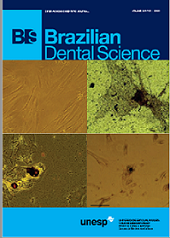Shear Bond Strength of Composite Repair System to Bilayered Zirconia Using Different Surface Treatments (In Vitro Study)
DOI:
https://doi.org/10.14295/bds.2020.v23i1.1893Resumo
Objective: the study is aimed to evaluate the effect of different surface treatment methods on shear bond strength between composite repair system and both of zirconia core and veneering porcelain and analyze the mode of failure between composite repair and ceramic surface. Material and methods: 40 Ceramic discs were fabricated with diameter of 7mm and 3mm thickness and divided according to material into two groups, Zirconia core discs (n = 20) and veneering porcelain discs (n = 20). Specimens were thermocycled and then each group was subdivided according to surface treatment method into 4 equal sub groups (n = 5) ,control subgroup I air abrasion, subgroup II Cojet, subgroup III laser, subgroup IV combination of air abrasion and laser surface treatment. Composite blocks were built up and polymerized on the surface of the specimens and shear bond strength of composite to each specimen was tested using a universal testing machine and mode of failure was evaluated using stereomicroscope. Results: Regardless of ceramic type; there was a statistically significant difference between surface treatments. Cojet recorded the highest mean shear bond strength. Laser showed the highest prevalence of adhesive failure. Porcelain + Cojet showed the highest prevalence of cohesive failure. Conclusion: Cojet surface treatment provided superior shear bond strength regardless of the ceramic type whether zirconia or porcelain. Porcelain provided superior shear bond strength values in comparison to zirconia regardless of the surface treatment method tested. Porcelain showed higher percentage of cohesive failure that while the mode of failure in zirconia was most commonly adhesive.
KEYWORDS
Laser; Porcelain repair; Zirconia repair.
Downloads
Downloads
Arquivos adicionais
Publicado
Como Citar
Edição
Seção
Licença
TRANSFERÊNCIA DE DIREITOS AUTORAIS E DECLARAÇÃO DE RESPONSABILIDADE
Toda a propriedade de direitos autorais do artigo "____________________________________________________________________" é transferido do autor(es) para a CIÊNCIA ODONTOLÓGICA BRASILEIRA, no caso do trabalho ser publicado. O artigo não foi publicado em outro lugar e não foi submetido simultaneamente para publicação em outra revista.
Vimos por meio deste, atestar que trabalho é original e não apresenta dados manipulados, fraude ou plágio. Fizemos contribuição científica significativa para o estudo e estamos cientes dos dados apresentados e de acordo com a versão final do artigo. Assumimos total responsabilidade pelos aspectos éticos do estudo.
Este texto deve ser impresso e assinado por todos os autores. A versão digitalizada deverá ser apresentada como arquivo suplementar durante o processo de submissão.




























